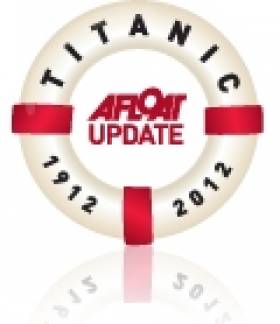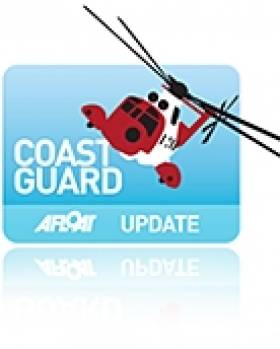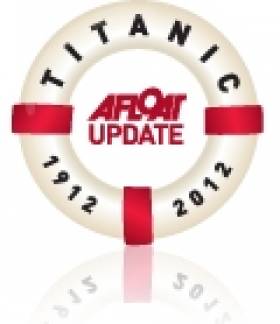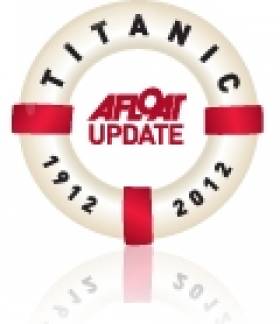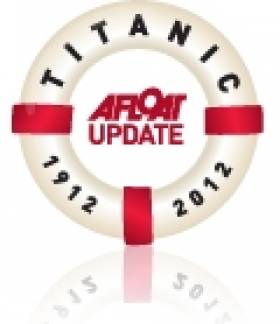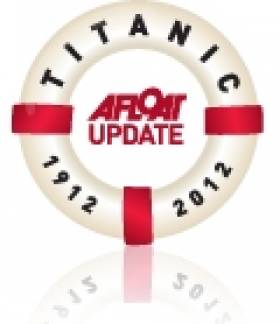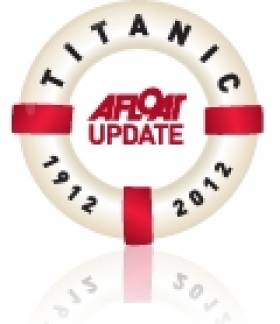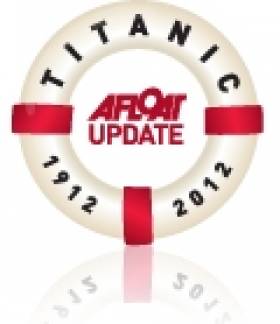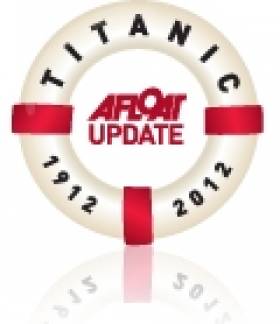Displaying items by tag: Titanic
'Titanic II' Plans Unveiled By Mining Millionaire
#Titanic - An Australian mining millionaire has unveiled his plans to resurrect the Titanic for the 21st century, as The Irish Times reports.
Clive Palmer wants to build a new version of the ill-fated cruise liner - to be dubbed Titanic II - recreating the style and comfort of the original, but with modern navigational instruments and enough lifeboats for all on board.
"Titanic was a ship of dreams and Titanic II promises to be the ship where dreams come true," he told reporters at the Ritz Hotel in London last week.
Already he claims that 40,000 people have enquired about passage, and 16 individuals have offered $1 million each for a state room on the new liner for its maiden voyage after the vessel is completed in late 2016.
Titanic II will not be an exact replica of its predecessor, as it's planned to be four metres wider to provide greater stability, as well as featuring stabilisers and reverse propellers to provide for a more comfortable voyage.
It will also not be built at Harland & Wolff, the Belfast Lough shipyards that constructed the original White Star Line vessel, instead being contracted to the world record-holding large ship facilities at Jiangsu in China.
The Irish Times has more on the story HERE.
MLA Dallat Welcomes Malin Head Reprieve
#Coastguard - East Londonderry MLA John Dallat has welcomed the news that the Irish Coast Guard station at Malin Head will remain open.
The SDLP politician had previously sought the support of Northern Ireland's Minister of State Mike Penning to help protect the Donegal coastguard station from closure in the wake of the 'value for money' report commissioned by Irish Transport Minister Leo Varadkar.
Last week Minister Varadkar made a U-turn on proposals to close one or both of the stations at Malin Head and Valentia Island in Co Kerry, following vocal protests by coastal communities in both areas.
As BBC News reports, Dallat's interest in Malin Head dates back to 1973, when he met divers salvaging items from the wreck of the Titanic sister ship Laurentic, which was sunk by mines off Lough Swilly in 1917.
Dallat joined the crew to salvage for brass and copper machinery from the wreck, but on the way to the site their boat experienced engine trouble.
It was only by contacting Malin Head that they were able to receive assistance from a passing coal boat - and Dallat believes he would not be here today if not for that coastguard radio call.
BBC News has more on the story HERE.
Titanic Plan Set to Go On Display
#TITANIC - The Irish Times reports that a hand-drawn plan of the Titanic will go on display at the visitor's centre dedicated to the tragic vessel in Belfast.
The enormous 10-metre drawing was used during an inquiry into the Titanic's sinking in 1912, and was donated anonymously to Titanic Belfast after selling at auction this summer for more than £200,000 (€250,000).
“I would say that it transcends economic value, given its role in Titanic history," said paper conservator Sean Madden, who worked on the project in his Lurgan studio. "Restoring and preparing the plan for display at Titanic Belfast has been an honour.”
The plan was shown at Belfast City Hall in April during the Titanic centenary events, and is set to be installed in the Aftermath Gallery at Titanic Belfast on the shores of Belfast Lough shortly.
The Irish Times has more on the story HERE.
Titanic Quarter Developer Makes a Loss
#TITANIC - Titanic Island, the company at the head of the consortium developing Belfast's Titanic Quarter, made a pre-tax loss of £20 million (€25 million) in 2011, as BBC News reports.
Much of this has been attributed to a one-off payment of £13 million (€16.25 million) to the charitable trust that owns the new Titanic Belfast visitor centre on the shores of Belfast Lough.
The company's directors described the opening of the tourism hot-spot as the "tipping point" for the development and that "the pieces are in place" for the Titanic Quarter to become one of Ireland's most important commercial hubs.
Meanwhile, Titanic Island is in discussions with Ulster Bank about restructuring its loan support, which the firm's auditors say is essential if the development is to continue.
BBC News has more on the story HERE.
Titanic Launch Ticket Tells The Story Of Its Legacy
#TITANIC - In the latest edition of his history of Ireland in 100 objects in The Irish Times, Fintan O'Toole examines the legacy of an admission ticket to the launch of the Titanic in Belfast on 31 May 1911.
On that day, he writes, "a huge crowd gathered at the Harland and Woolf shipyard at Queen's Island in Belfast Lough for the launch of the great transatlantic liner Titanic. Among them were many of the workers who had built it. This admission ticket belonged to David Moneypenny, a ship's painter who worked on the first-class quarters."
He adds: "For him, for his colleagues, for Belfast and Protestant Ulster, this was a moment of extraordinary accomplishment. Titanic was at the leading edge of 20th century technology."
O'Toole positions the Titanic as a symbol of Belfast's remarkable growth in the late 19th century to become Ireland's largest and most productive city, largely built upon the "kind of globally significant industry" that Dublin and southern Ireland were sorely lacking.
But while marking the gulf of separation between these two Irelands - the largely Protestant industrial powerhouse and the Catholic land "of romantic peasants" - Titanic also represented two very different versions of Ireland in popular culture: one of the hundreds of post-Famine emigrants who died when the ship sank on 15 April 1912, and that of the start of what O'Toole describes as "an almost apocalyptic sense of threat" to the Ulster Protestant identity, the reverberations of which are still felt today.
The Irish Times has more on the story HERE.
Record Year for Cruise Visits in Belfast
#BELFAST LOUGH - Belfast may no longer be building ships but it's certainly attracting them as 2012 marks a record year for luxury cruise ship numbers, according to BBC News.
Nearly 80,000 passengers and crew from 111 different countries have come through the city's port via 43 cruise liners since the start of this year's cruise season - and more than 50 are expected to sail into Belfast Lough in 2013.
Northern Ireland's tourism hotspots are the big attraction for most, from the world-renowned Giant's Causeway to the new Titanic Belfast visitor centre - but curiosity is also a big driver.
"A lot of people are curious about Belfast and Northern Ireland," said Gerry Lennon of the Belfast Visitor and Convention Bureau. "The political stability has given us that ability to go to the market-place and now say 'look what we have to offer'."
BBC News has much more on the story HERE.
Titanic Scale Model Focus of High Court Dispute
#TITANIC - A replica of the Titanic is at the centre of a High Court dispute between two former partners, as RTE News reports.
Carmel McGrath claims she paid the costs of constructing the 16ft scale replica of the tragic cruise liner, and has secured an injunction preventing Zoltan Panka, a Hungarian national, from selling the €70,000 model after he removed it from her home in the northern suburbs of Cork.
Panka gave a sworn statement to the court disputing the claims of his former partner, alleging he received abusive messages from her after taking the model.
He denies any intention to sell the replica, currently believed to be at a location in Carrigaline, and repudiates the estimated value of McGrath's investment as well as any commercial relationship between the two.
The Hungarian added that model ship building was a family hobby, and that he had put in as much as 2,000 hours' worth of work into the uncompleted project, which was intended to mark the 100th anniversary of the ship's demise.
RTE News has much more on the story HERE.
Rory Golden Returns to the Titanic With Stage Show
#TITANIC - The first Irishman to see the wreck of the Titanic takes to the stage in the UK next week to present his personal recollections of the experience.
As Biggleswade Today reports, deep-sea diving expert Rory Golden will give his two-part presentation Return to the Titanic at the Gordon Craig Theatre in Stevenage next Wednesday 26 September.
The show - previously hosted at the Marine Institute earlier this year - covers the history of the ill-fated cruise liner's construction at Harland & Wolff in Belfast, through its tragic demise in 1912, and its eventual rediscovery on the North Atlantic sea bed in 1985.
Fifteen years after the wreck was found on a French/American expedition, Golden descended the nearly 4km below the surface on a Russian submarine to witness the watery grave site for himself - and his show lets the audience see some of the magnificent sights he saw.
“When I first cast my eyes on the wreck," he told JOE.ie in April this year, "for me it was just an incredibly exciting and equally humbling and incredibly poignant moment and you have all these emotions all at once because you are looking at something very few people in the world have seen.”
Titanic's Galway Passengers Commemorated This Month
#TITANIC - Nine Galwegians who travelled on the ill-fated Titanic are being commemorated throughout August by a replica of the ocean liner, as the Galway Advertiser reports.
The 1:10 scale model is on display overlooking Galway Bay at the Atlantaquaria on Salthill promenade, on loan from the village of Addergoole in Mayo which lost 11 of the tragic 'Addergoole Fourteen' in the disaster a century ago.
Six of the nine Galway residents on the ship lost their lives. But among the survivors was a Eugene Patrick Daly, who provided key testimony that painted a fuller picture of what happened on the night of 15 April 1912, and led to the passing of stricter lifeboat laws for passenger vessels.
Tribute to 'Forgotten' Titanic Workers in Belfast
#TITANIC - A new plaque has been unveiled in Belfast to remember eight men who died during construction of the Titanic in the city more than 100 years ago.
As UTV News reports, NI First Minister Peter Robinson was on hand at the unveiling of the tribute on the wall outside the Harland & Wolff Welders Club on Dee Street in East Belfast.
The First Minister described the eight men as an integral part of the Titanic story.
"In an era when the phrase 'health and safety' did not even exist it was seen as an inevitability that lives would be lost during any major construction or engineering project.
"It is important the story is told of those who built what was the largest ship afloat at that time."
Construction of the ill-fated cruise liner began in Slipway No 3 at the Harland & Wolff shipyards in March 1909, more than two years before her launch.
The workers' tribute joins a new memorial in the grounds of Belfast City Hall that lists the names of all 1,512 passengers and crew who perished in the tragedy.
UTV News has more on the story HERE.


























